Port Adelaide Anchor Trail Update
by Steve Reynolds
Since we completed the guide for our Port Adelaide Anchor Trail, I have remained busy on the project. I have, for example, distributed hard copies of the guide, along with a poster, to a large number of locations close to some of the anchor sites.
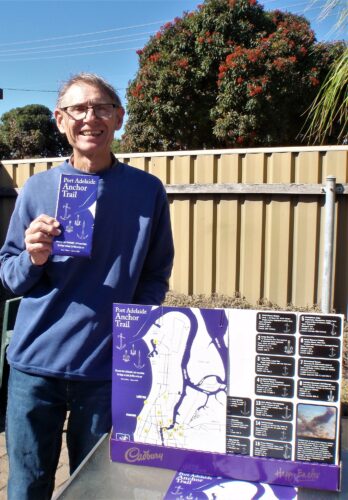
The initial list of these locations can be found at https://wp.me/p4BvtZ-12M. I have also handed out a few individual copies of the guide to interested persons.
I have kept visiting some of the anchor sites to encourage anchor ‘owners’ to do any necessary restoration work needed.

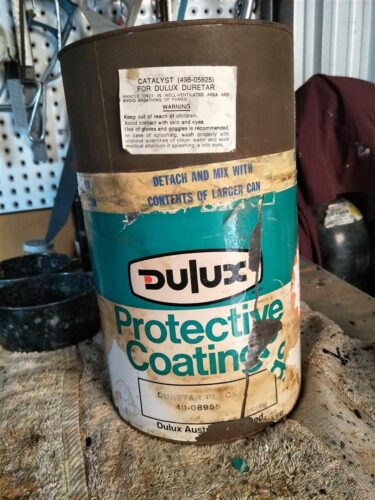
Paint that I provided to the Austbuilt Museum to restore the anchor above
I have also visited several of the anchor sites to tidy them up by picking up litter and weeding. I call it ‘taking a personal interest’ in the anchors.
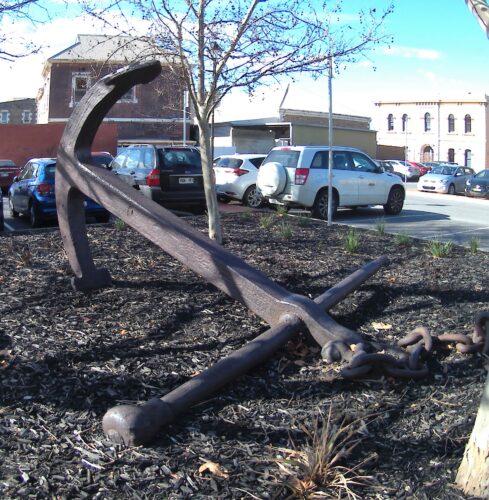
I was also invited to present details of our trail to the Nautical Archaeology Society’s Maritime Archaeology Course: Anchor Recording using the Big Anchor Project Online Database being held in the UK in June. I was able to finish my presentation just before bedtime due to the time difference.
Since the course was held, Peta Knott, Education Manager for the Nautical Archaeology Society (NAS) has provided some anchor related resources and references: –
A quick reference book for anchors
An anchor timeline (this is the middle section of the timeline document): –

There are many anchor articles in the International Journal of Nautical Archaeology which can be accessed online by NAS members.
A further 3 main references are:
Wilson, A. I., ‘Developments in Mediterranean Shipping and Maritime Trade from the Hellenistic Period to ad 1000’, in D. Robinson and A. Wilson (eds), Maritime Archaeology and Ancient Trade in the Mediterranean, Oxford Centre for Maritime Archaeology Monograph 6 (Oxford, 2011), 33–59
Votruba, G. F. 2014, Iron Anchors and Mooring in the Ancient Mediterranean (until ca. 1500 CE), unpublished D.Phil thesis, University of Oxford.
Votruba, G. F. & Erkurt, O., 2017, The World Anchors Reconstruction and Experimentation Project (WAREP): an introduction, in J. Gawronski, A. van Holk & J. Schokkenbroek (eds), Ships and Maritime Landscapes: Proceedings of the Thirteenth International Symposium on Boat and Ship Archaeology, Amsterdam 2012, 356-60. Eelde.
Votruba, G.F., 2019, Building upon Honor Frost’s Anchor-Stone Foundations, in L. Blue (ed.) In the Footsteps of Honor Frost: The life and legacy of a pioneer in maritime archaeology. Sidestone Press. 213-244 and 278 – 291.
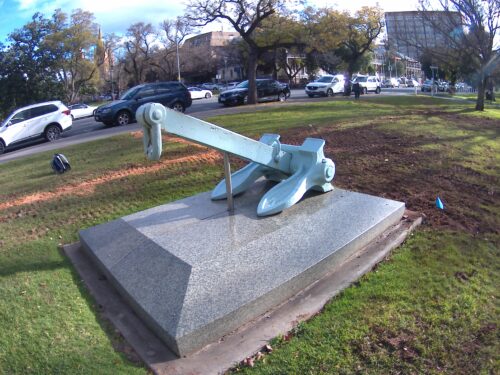
Anchor in the SA Naval Memorial Garden
in Sir Edwin Smith Avenue, Adelaide
I have also been sussing out new anchor sites for possible future trails. One helpful resource is the Google map that “shows the location of (many) ‘largish’ anchors both in & on water and land in South Australia”. Beware though because some of these anchors have since been relocated. Some known anchors are missing from the map.
I will keep busy maintaining the anchor sites and delivering hard copies of the guide either to new locations or locations that have run low on the guides.
The scene is now set to start doing detailed measurements of many of the anchors for entry into The Big Anchor Project database. (Some of the anchor measurements have already been done.)
Meanwhile, there are more anchor sites out there (around Port Adelaide), but these were not considered as part of the trail. Some of them are only replica anchors. One such replica can be found inside the south-west corner of the fence around the water-slide park at Semaphore jetty.
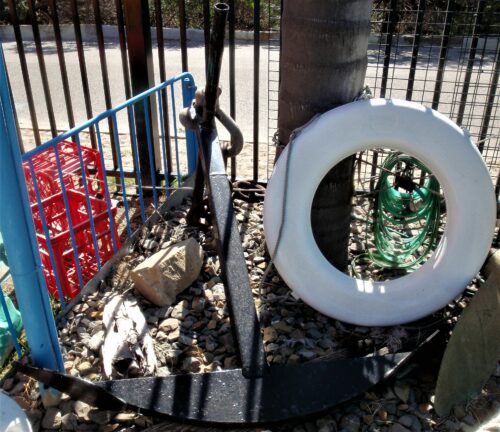
Another replica anchor can be found at the SA Trailer Boat Club Inc., Bourne-Jones Rd, Outer Harbor (off of Victoria Rd & Oliver Rogers Rd). It is located between the Royal South Australian Yacht Squadron & the Scouts (SA) Water Training Centre. This is only a replica (home-made) anchor made and donated by Max Peterson in January 1994. It has been described by Nick Reed of the Big Anchor Project as “Admiralty pattern anchor but looking at the size and construction looks like what we would refer to as a fisherman’s anchor. It looks like it should be 20th century, probably later half. Interesting way in which the crown is attached to the shank.”
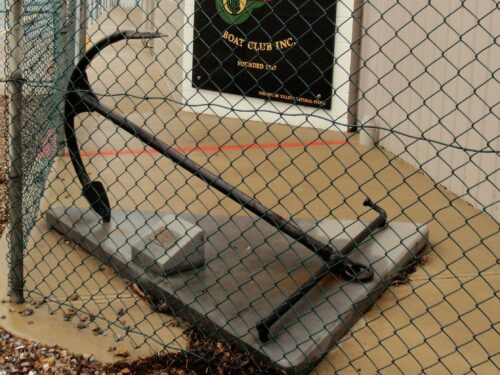
Yet another replica anchor can be seen within the Port Anchor Hotel, 15 Church St, Port Adelaide. This replica anchor is displayed inside the hotel as part of the hotel’s many promotional signs. The hotel was first opened in 1876 as the Kent Hotel (see http://portanchorhotel.com.au/ ). This anchor has been described by Nick Reed of The Big Anchor Project as another “fisherman’s anchor of similar construction to the Outer Harbor one. Its stock is in the wrong plane for functionality and would suggest that it is (purely) decorative. Flukes also look as if they would be too weak to be functional.”
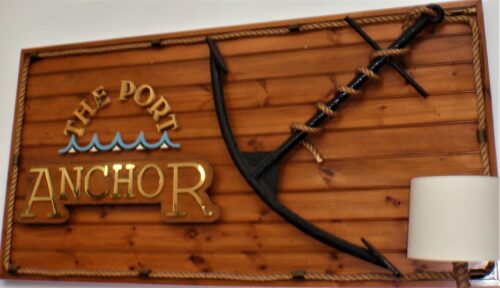
There is a very large anchor at the Wingfield dump. It is located adjacent to the Education Centre within the Wingfield dump. It is not, however, easily accessible to the general public due to the heavy traffic passing through the dump. It is a Danforth* anchor (with crown stock) – shank 3.15m long, stock 2.577m wide, ‘5000 lbs’.
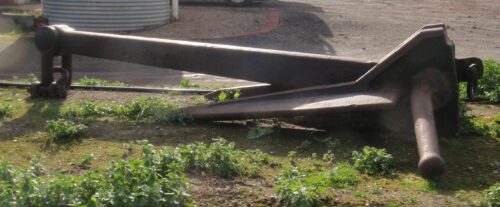
* (Designed by Richard Danforth in 1939. The anchor was widely during World War II for anchoring aircrafts, bridges and boats. Two large flat triangular flukes are attached to a stock at the crown. If buried well, the anchor can develop high resistance and is also easy to retrieve.)
Several ‘ships’ berthed along Queen’s Wharf, between the Birkenhead Bridge on Nelson St. and No.1 Dock on Ocean Steamers Rd, bear anchors that can be seen from the wharf. These ‘ships’ include the Dolphin Explorer, the steam tug Yelta, the sailing ship Falie, the tall ship One and All and several recreational pleasure boats. The Yelta carries a spare anchor inside her bow.
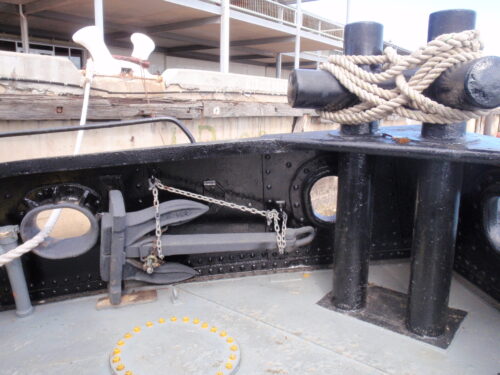
The flukes on the anchor of the auxiliary ketch Falie have been said to have a distinctive diamond on them, and there is also a raised rim around the edge of the arms and flukes, suggesting that it is a “Byers” anchor (see further below). Supporters of the Falie celebrated its centenary in 2019. The vessel was built in the Netherlands 1919.
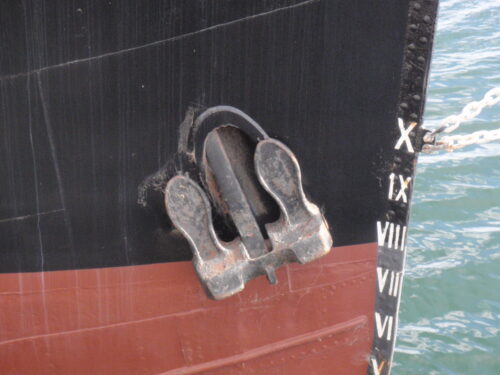
The anchor on the tall ship One and All has been described by Nick Reed of the Big Anchor Project as looking “like a Hall or Union stockless anchor. Certainly 20th century. This anchor shows how a stockless anchor would slide up into the hawse pipes for stowage.”

Each of these vessels are moored at the wharf most, if not all, of the time and they allow visitors onboard at times. There are two large anchors hanging from the barge Bradley holding the clipper ship City of Adelaide whilst it is moored in Dock 2 awaiting a more permanent location. These anchors are 2.1m long and arms that have a total width of 1.4m.
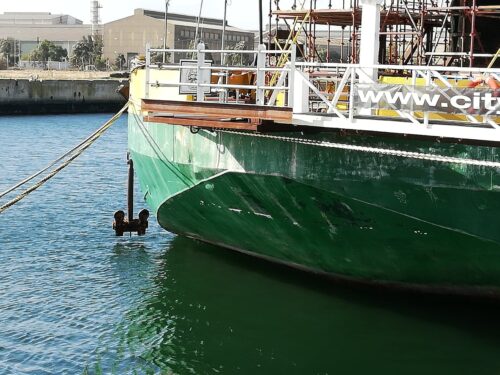
The flukes of the anchor on the barge Bradley are rounded, suggesting that the anchor is either a Byers* or a Baldt-style stockless anchor. probably mid to late 20th century.
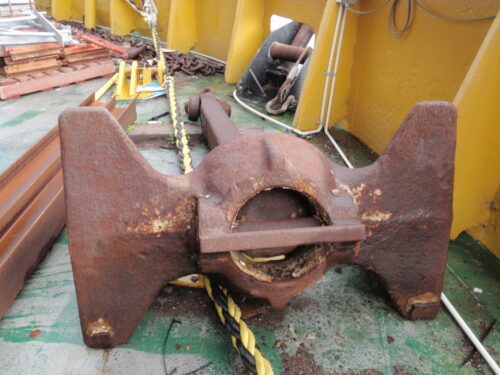
* (Byers were a ubiquitous make until the advent of cheap anchors from the far east during the latter half of the 20th century. Prior to WW2, they often had a swastika on them. This was taken from the Sanskrit symbol of good luck rather than any association with the Nazis. This feature often leads them to be misidentified as WW2 German.)
The 1883-built ‘tug’ Nelcebee, dry-docked at Dock 2, carries a stockless anchor which can be seen when visiting the area. It has been suggested that its shape indicates that it is a KLIP anchor, but that the fluke shape seems to indicate a variation.
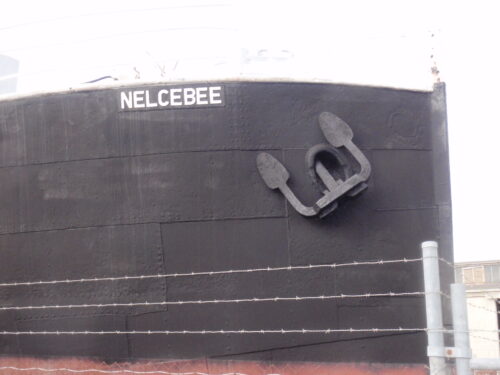
More vessels with anchors can be found further west, past the Birkenhead Bridge, at the site of the Australian Maritime & Fisheries Academy, 20 North Parade, Port Adelaide. More vessels may be viewed at various locations north along the river. Some ships’ berths may be accessible, and some may not be. Large ships also berth at Outer Harbor (correct spelling), but it will be difficult to get close to these vessels. There is, however, a small fishing landing adjacent to the Pilot Station at the end of both Lady Ruthven Drive and Oliver Rogers Road that may assist a little.
Even more vessels with anchors can be found at the Torrens Island Market located at the end of Moorhouse Road (near the end of the Grand Trunkway), Port Adelaide, but access to the vessels is via a normally locked gate to the two pontoons at the wharf.
(The old tug Fearless located on land between the Birkenhead Tavern and the Birkenhead Bridge still carries two anchors on its bow, but these cannot be seen up close due to fencing around the vessel at present. One of the anchors has been described by Nick Reed of the Big Anchor Project as “Stockless anchor, hard to tell the make but it looks like a Union type. Boat looks like it is late 20th century so that would date anchor.” Mr. Keith Le Leu had bought the Canadian-built tug Fearless in Brisbane in 1972 and it was eventually land-locked at Birkenhead.)
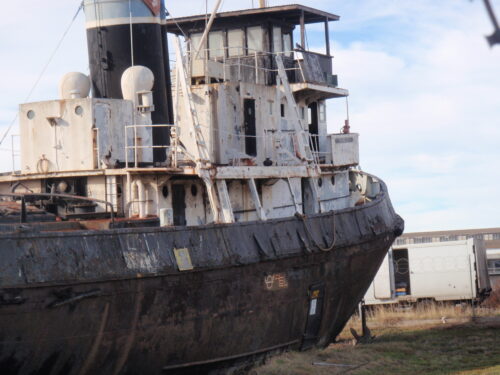
We can now list details of the Port Adelaide Anchor Trail’s anchors and their locations (in alphabetical order): –
Birkenhead (2)
Birkenhead Riverview Tavern, Riverview St, Birkenhead (either side of the river side of the Tavern) – 2 large anchors. These are located either side of the river side of the Birkenhead Tavern, which first opened in 1878. There is both a stocked anchor and a stockless anchor (adjacent to a large propeller) there.
Proximity to walking/cycling track: Cycle lanes are located nearby
The stocked anchor is over 3.4m long. It has a 3.1m-long stock and the total width of the arms is over 2.3m. This anchor is probably the most common style of anchor on display around the world. It is an Admiralty Pattern anchor with a folding stock (designed to be folded when not in use so that anchor can be stored on deck). It came into common use during the mid to late 1800s. These were often stored on a vessel as a back-up anchor. This particular anchor has been described by Nick Reed of the Big Anchor Project as having a faceted shank, and it seems to be cast rather than hammer-welded it, suggesting that it is from the early to mid-20th century.
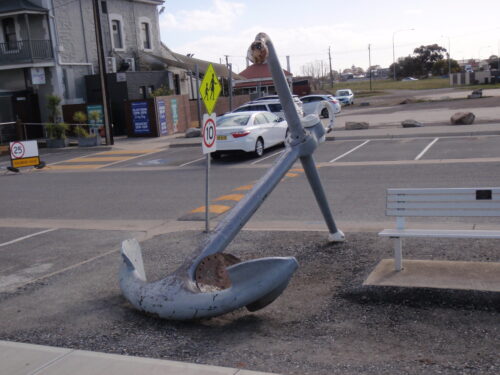
The stockless anchor is 2.5m long, with a 1.4m base and the total width of the arms being 1.4m. It is located adjacent to a large propeller is described as a standard stockless anchor, which was first patented in the early 1800s (Hawkins 1821) and became the standard anchor for most larger vessels. It has been suggested that this particular anchor could be a “Union” or “Hall’s” style anchor, estimated to be from the mid-20th century.
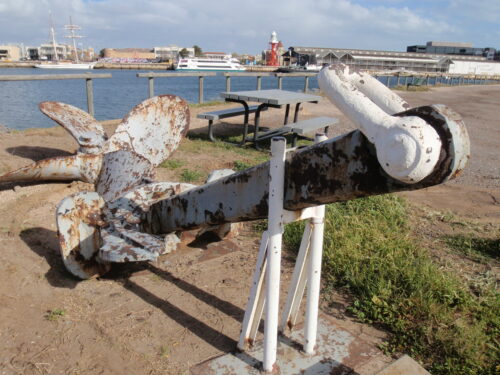
Both anchors were donated by the late Keith Le Leu, OAM (a local Port Adelaide identity who died in 2006) between 1992 and 1994. Both anchors were erected at Birkenhead by the City of Port Adelaide in August 1995. Plaques at each anchor give details of the commemorations that the anchors each mark.
Largs Bay (3)
Largs Bay Jetty, Esplanade/Lady Gowrie Drive, Largs Bay – 1 large (mooring?) anchor 2.5m long & wide (opposite the Largs Pier Hotel, and immediately south of the Largs Bay Kiosk by the jetty).
Proximity to walking/cycling track: On coastal walking & cycling track (Coast Park/Coastal Path) and there are also cycle lanes on the Esplanade.
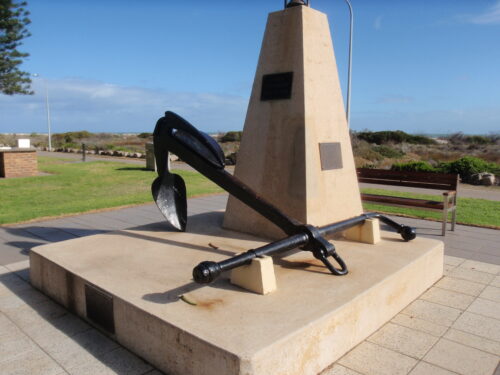
The large stocked anchor sits at the base of a cairn commemorating the centenary of Largs (Bay). The cairn was erected by the Rotary Club of Largs Bay and unveiled by HCR (Roy) Marten, the Mayor of Port Adelaide on 1st January 1983. It has been described by Nick Reed of the Big Anchor Project as a Standard Admiralty pattern anchor, which are common throughout the UK and likely to be from the late 19th century. It has been suggested that this one has been used as a mooring anchor because the “top” arm has been bent over. This would have prevented the hull being damaged by the upward facing arm if the tide dropped too much. The arm is said to show evidence of a break. It is unclear whether this was why it was used as a mooring anchor, or if it was broken during bending over.
Largs Bay RSL, 17 Carnarvon Tce, Largs Bay – 2 stockless anchors over 1m high.
Proximity to walking/cycling track: On Outer Harbor Greenway track. Also on the Mudlangga to Yertabulti Track.
One anchor is located at the front of building and another anchor is located at the right-hand side of the building. These two anchors have been described as “Typical small stockless anchors, most likely a Union type. Details on the arms often give weights, etc..” These two anchors are both stamped 150 kgs (3 cwt?).
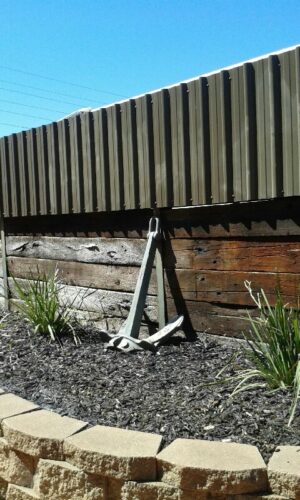
(cwt = hundredweight. According to Wikipedia, “The hundredweight (abbreviation: cwt), formerly also known as the centum weight or quintal, is an English, imperial, and US customary unit of weight or mass of various values. Its value differs between the American and imperial systems. The two values are distinguished in American English as the “short” and “long” hundredweight and in British English as the “cental” and the “imperial hundredweight”.” Taking this a step further:
BRITISH – a unit of weight equal to 112 lb avoirdupois (about 50.8 kg)
US – a unit of weight equal to 100 lb (about 45.4 kg)
OTHER – a unit of weight equal to 50 kg)
New Port (1)
Entrance to the Naval Reserve Cadets, Jenkins Street, New Port (formerly Birkenhead) – 1 stocked anchor.
Proximity to walking/cycling track: On Inner Harbour Loop Path.
This anchor has a shaft over 2.35m long, a (new) stock of around 2m and arms that have a total width of 1.6m. It has been described by Nick Reed of the Big Anchor Project as a Standard Admiralty pattern anchor with a removeable stock. The flukes of the anchor seem to have either been removed or have been damaged. It is estimated to have most likely been a 20th Century anchor. It may well have been “folded” up and carried as a spare anchor. It was placed at this site in May 2019 to replace the large artillery gun now adjacent to Semaphore jetty. The plaque at the anchor was originally placed with the gun at the entrance to the Naval Reserve Cadets.
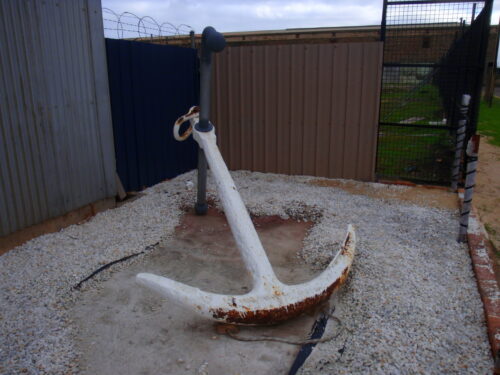
North Haven (1)
North Haven Marine, Shop 1, 23 Alexa Rd, North Haven – 1 (Admiralty Pattern) stocked anchor which is 1.36m long and arms that have a total width of 1.09m. It is located out the front of the shop. Enter the shop to view many modern-type anchors.
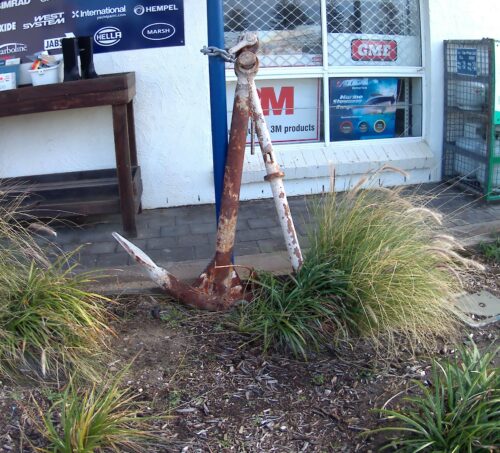
Port Adelaide (4)
Adelaide Dockside Self Storage, Port River Expressway (east side of the Diver Derrick Bridge. Access via Wauwa St.) – This anchor is 1.7m long and arms that have a total width of 1m. It came from the barge Bradley, the barge currently supporting the City of Adelaide clipper ship. The anchors currently on the barge are 2.1m long. This particular anchor has been described by Nick Reed of the Big Anchor Project as a standard mid to late 20th century stockless anchor. It has been suggested that the shape of the flukes (distinctive spade shape), raised ridge on the arm and flat “weight” at the bottom would suggest possibly a “Spek” style anchor.
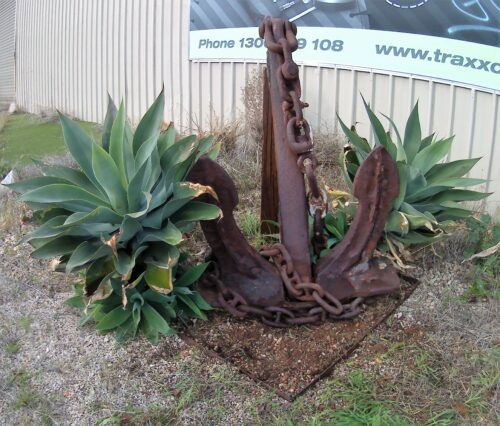
Naval Association of Australia, 35 Quebec St, Port Adelaide (adjacent Port Mall Shopping Centre) – 1 stockless anchor 1.2m long (+ a flagstaff featuring an anchor inside the centre). The stockless anchor outside has a weight of 4 cwt. It has been suggested that this anchor looks like it’s a “Byers” clone (manufacturers would adapt design for ease of manufacturing). It has been estimated as being from the mid to late 20th century. It was unveiled by Mr Rod Sawford, the Federal Member for Port Adelaide, on 15th August 2005 to commemorate the 60th anniversary of V.P. Day (Victory in the Pacific Day, or Victory over Japan Day). This anchor was donated by the family of A.B. W.H.(Harry) Cadd, ex HMAS Norman. HMAS Norman was a RAN N-class destroyer on loan from the Royal Navy during World War II.
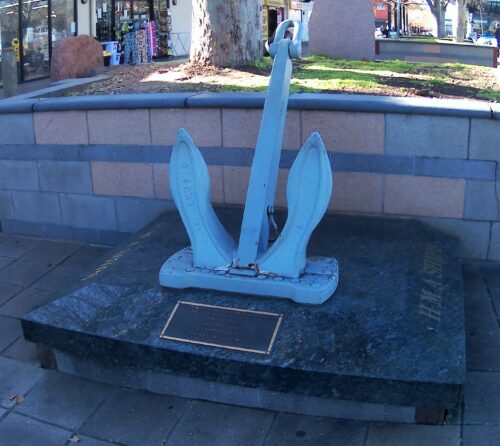
(There are many insignias on display inside the Naval Association centre that feature an anchor, but the centre is only open at limited times.)
North Parade, at the edge of the small car park on the corner of Robe St and Nile St. – 1 large stocked anchor. The stock is some 3.5m long, the shaft around 3.3m long and the arms have a total width of 2m. The anchor is said to be a Rodger’s small palm anchor, after Lieut. William Rodger RN, (because the flukes, or the “palms” almost look delicate compared to the anchor). It is possibly from the mid-1850s*. It is believed to be the mooring anchor for the old steamship mooring buoy at Largs Bay, where passengers were ferried ashore by small boats prior to the Outer Harbor being developed. This anchor is said to have an “Interesting squared shank. Straight stock fastened by a cotter pin. Stock could be removed to aid stowage.” The Rodger’s small palm anchor has been described by Nick Reed of the Big Anchor Project as “Well thought of and designed to give better grip.”

* (The chain attached to the anchor is stamped “1916”.)
(At the time of writing, the Port Adelaide Enfield Council is considering relocating the anchor, although they don’t expect this to happen for a year or two.) Visit the building adjacent to the anchor at 27 North Parade whenever it is open to enquire about Port Adelaide’s environmental landscape.
Quin Marine, 331 St Vincent Street East, Port Adelaide – 1 large stocked anchor
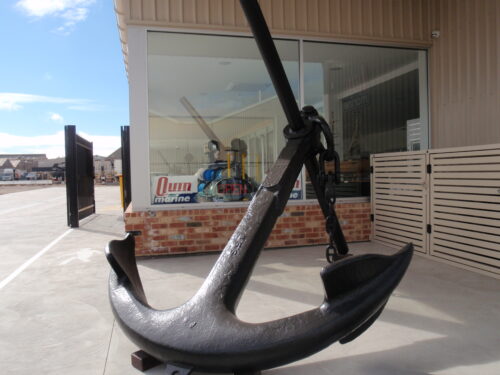
This anchor is 3.3m long, has a stock that is also 3.3m long, and arms that have a total width of 2.4m. It has been described by Nick Reed of the Big Anchor Project as “20th Century stocked anchor – admiralty pattern. Distinct tip to palms / flukes known as a bill. Ring at the end of the crown for attaching a buoy to assist with tripping of the anchor. Sometimes known as a fishbuckle or tripping ring.”
Royal Park* (1)
Old Port Road – middle of the junction of Old Port Rd, Webb Street & Frederick Rd, (* Royal Park, Queenstown, West Lakes or Port Adelaide) – 1 large stocked anchor over 3m long.
Proximity to walking/cycling track: Bike lanes are present.
This anchor possibly may be partially hidden by foliage. It was placed there by the then Woodville Council as part of SA’s Jubilee celebrations in November 1986. It was placed there adjacent to an earlier perma-pine structure representing HMS Rapid to commemorate Col. William Light’s journey up the Port River. The purpose of the anchor was to enhance the replica Rapid rather than having any historical significance. The anchor is said to have been obtained from a shipping junk yard or similar. It has been described by Nick Reed of the Big Anchor Project as “Admiralty pattern anchor with shackle rather than ring. Suspect that it is 20th century. Looks like it has a squared shank with straight stock.”

Semaphore (2)
Semaphore Jetty, Esplanade, Semaphore (between the clock tower memorial and the large artillery gun adjacent to the jetty) – 1 large stocked anchor from the Star of Greece shipwreck.
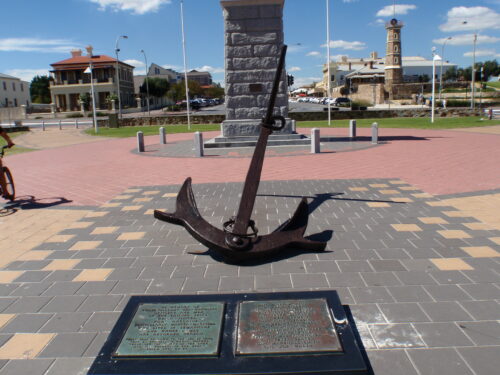
Proximity to walking/cycling track: On costal walking & cycling track (Coast Park/Coastal Path)
This anchor is 3.36m long, has a stock over 2.5m long and arms that have a total width of 1.8m. It is a Trotman’s swing anchor from the 1888 wreck of Star of Greece at Port Willunga. It is part of the “Sea Captains’ Memorial” built by the Port Adelaide Council and unveiled by the Port Adelaide Mayor, HJ Moore in April 1952. It was originally located just north of the Semaphore jetty, just before the Palais. It was said to be “10 ft. 6 in. long and weigh between 25 and 30 cwt” at the time.

The Trotman anchor was patented in 1852 by John Trotman. He introduced a pivot where the anchor’s arms join the shank, allowing the “idle” arm to fold against the shank. It is the most successful of patent anchors.
Le Fevre High School, 90 Hart Street, Semaphore South (corner of Hart St & Swan Tce) – 1 large stocked anchor donated by Keith Le Leu. It is 1.5m long and arms that have a total width of 1m. The stock has been bent out of shape. This anchor has been described by Nick Reed of the Big Anchor Project as an Admiralty pattern anchor, which looks like a ‘Rodger’s small palm’ due to the small spade-shaped fluke (or palm). It has been suggested that this would date the anchor from the 1850s onward. The shank has been described by Nick Reed of the Big Anchor Project as ‘squared’ and looking like it has been hammer-welded, supporting dating as from the 1850s onwards.
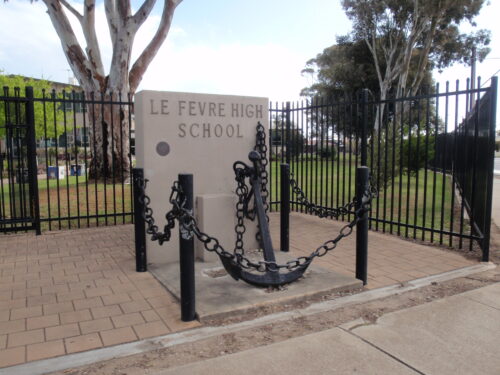
West Lakes (1)
Frome Reserve, Frome Crescent, West Lakes -1 large stocked anchor (adjacent children’s playground).
Proximity to walking/cycling track: Close to a bike track.
This is said to be a bower anchor, one of the two main anchors of a ship. These are carried on each side of the ship’s bow and permanently attached to their cables. These anchors are always ready to be let go in case of an emergency. This particular anchor is a Trotman’s anchor about 2.7m long. It was placed there in 1972. It is described as being from “around mid to late 19th century (came into common use around 1850). Was an attempt to solve the issue of storing the anchor. Hinged at the crown. Also solved the issue of fluke and arm sticking up when it was at anchor. Concept lead to the stockless anchor.”
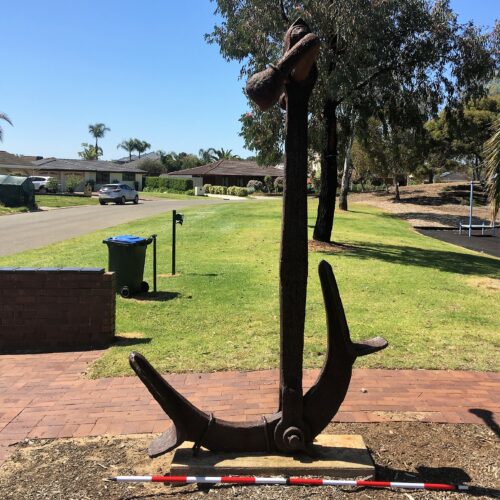
Anchors which can be seen inside museums
Two anchors can be seen inside the South Australian Maritime Museum, 126 Lipson St, Port Adelaide (entry charges apply). One is a 4m-long, 1-tonne stocked anchor from Matthew Flinders’ ship Investigator. The other one is the anchor on the bow of the replica ketch Active II (both inside the Museum). That anchor has been described by Nick Reed of the Big Anchor Project as “Admiralty pattern, shows hammer welding & round crown (probably putting it late half of 19th century) The anchor shows how stocked anchors would be stored. The anchor is “catted”. The white beam sticking out ahead of them anchor is known as a cathead.”
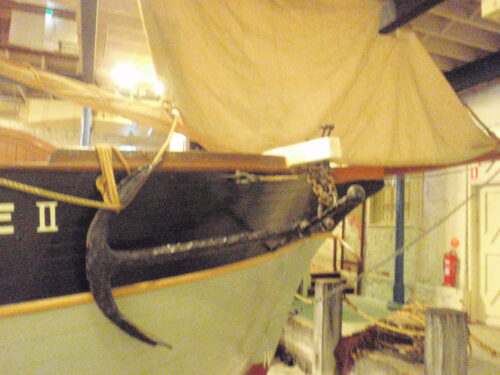
The Investigator’s anchor is possibly the oldest known anchor in South Australia. It has a (replica) large wooden stock. It is a ‘best bower anchor’. A bower anchor is each of two anchors carried at a ship’s bow. The best bower anchor is the starboard bower anchor, whilst the port bow anchor is called the small bower anchor.
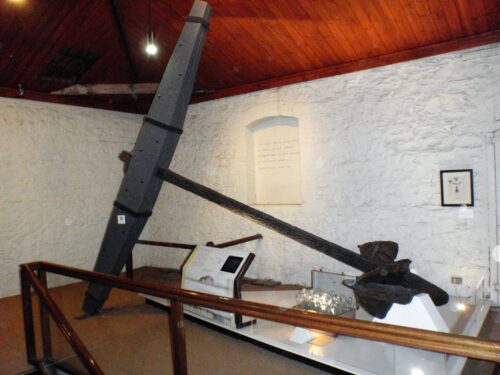
This particular anchor is the largest of two anchors that were cut loose by Matthew Flinders during rising winds in 1803. These were located in Goose Island Bay on 14th January 1973 by members of the Underwater Explorers Club of SA. The anchors were both raised up by the lighthouse ship Cape Don on 19th January 1973. Video footage in the museum shows the two anchors being recovered. They have now been preserved and restored. The smaller anchor, a 3m-long, 406kg stream anchor, was placed in Canberra along with an anchor from James Cook’s Endeavour. Remember that entry charges apply to go inside the South Australian Maritime Museum.)
Two anchors can also be seen at the Austbuilt Museum, 95 Fletcher Road, Peterhead. There are two stocked anchors – 1 large, 1 small. Both can be seen just inside the Museum’s front gate & fence. Details of the two anchors are unknown. The museum, which was commenced by Mr. Keith Le Leu in 1962, houses a collection of shipping artefacts and memorabilia. Mr. Le Leu donated his museum to the Port Adelaide Historical Society in 2004. The museum is open from 2 – 4pm each Sunday. An admission fee applies to enter the museum. Contact the Society’s Secretary at secretary@porthistory.net or the museum direct at museum@porthistory.net .

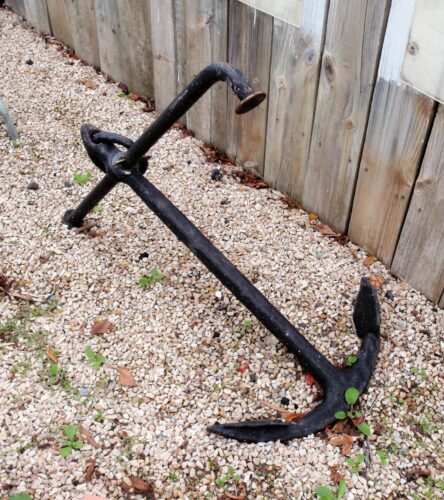


Steve, the Council certainly got their money’s worth with this anchor project. You have applied your usual thorough attention to detail and perspicuity in the above article. Of course I also acknowledge Dan Monceaux’s significant involvement in the project ,from inception. Well done, both!
Dave Muirhead (MLSSA secretary)
[…] Port Adelaide Anchor Trail Update https://mlssa.org.au/2020/07/01/port-adelaide-anchor-trail-update-2/ […]